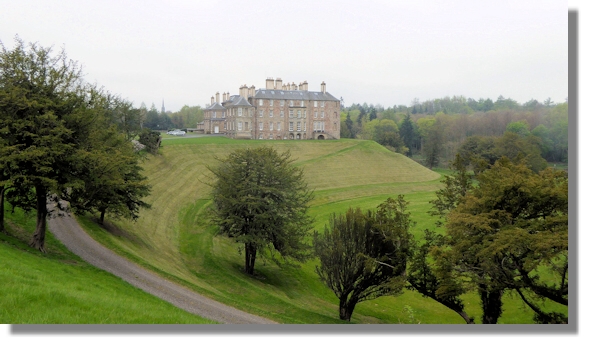
Places to Visit in Scotland
- Dalkeith Palace and Country Park

Early History
Prior to the creation of Dalkeith Palace, the original Dalkeith Castle was located to the north east of Dalkeith, in the hands of the Clan Graham in the 12th century and then was given to the Douglas family in the early 14th century. James Douglas of Dalkeith became the Earl of Morton in the mid-15th century (that's the Douglas Earl of Morton Crest on the left). The castle was strategically located in an easily defensible position above a bend in the River North Esk. Nearer the centre of Dalkeith, James Douglas,1st Lord Dalkeith, endowed the collegiate church in 1406, where Douglas earls lords and knights were buried.
Margaret Tudor, the bride of King James IV of Scots (pictured on the right), stayed here as the guest of the Earl of Morton, before her formal entry to Edinburgh in 1503. In 1543, David, Cardinal Beaton, the Archbishop of St Andrews, was imprisoned in Dalkeith Castle. The castle was captured during the war of the Rough Wooing by the English in 1548.
From June 1574, Regent Morton, who had been captured at the siege of 1548, extended the castle and palace. Its appearance was recorded in an engraving c.1690 by John Slezer (who erroneously entitled the engraving 'Glamms House') - and it looks a formidable building. When James VI of Scotland (pictured on the left), reached his majority in October 1579, following celebrations in Edinburgh, Morton entertained the young King at Dalkeith Palace.The building is called a 'palace' in part because Dalkeith Castle was the 'caput', the 'head' or place where the courts of the Regality of Dalkeith were held. According to the heraldic writer, Alexander Nisbet, the caput of a regality was technically termed a 'palatium', as a seat of royal authority. In 1642, Dalkeith Castle was sold by the Douglas family to Francis Scott, 2nd Earl of Buccleuch.
From Castle to Palace
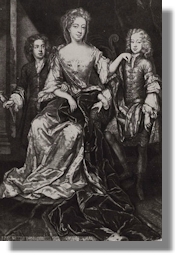
The 2nd Earl of Buccleuch's daughter married the Duke of Monmouth, son of King Charles II. They became the Duke and Duchess of Monmouth & Buccleuch. After the Duke of Monmouth had been executed for treason, Anne Scott, his widow (pictured here with her two sons), who held the Scottish title in her own right, asked architect, James Smith, to use William of Orange's Palace of Het Loo in the Netherlands, as a model for a new Dalkeith Palace.
Construction of Dalkeith Palace began in 1702, Smith deciding to incorporate a portion of the tower house of the old castle into the western side of the new structure. The outline of the old tower walls is still visible in the western facade of the palace today (see graphic on the right). The majority of construction was complete by 1711.
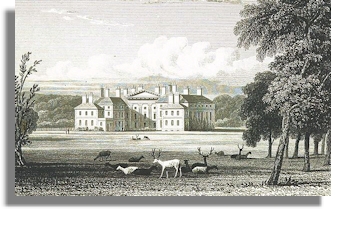
Dalkeith Palace in 1827 (via Wikimedia Commons )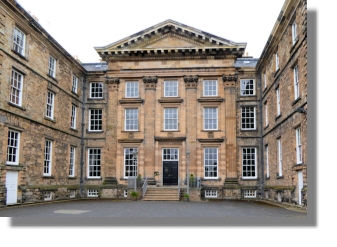
Main Entrance Dalkeith Palace Now
Overall, the Palace is built of sandstone and has the main entrance on the south front, flanked on each side by two Corinthian order pilasters. These are surmounted by a bracketed pediment unusual for its depth. The layout of Dalkeith Palace was unusual for the time in that the state apartment was located on the ground floor, which prevented the Great Dining Room from being placed in its customary position at the start of the state apartment.
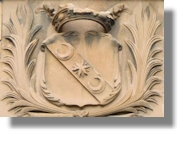
A sculptured stone representation of the Buccleuch sun and crescent moons crest is on the front of the building.
A later addition near the end of the 18th century was the monumental Montagu Bridge over the North Esk river designed by Robert Adam (see graphic on the right.
Bonnie Prince Charlie stayed two nights, during the Jacobite Rebellion, at Dalkeith in 1745, King George IV slept there during his visit to Edinburgh in 1822, in preference to Holyroodhouse Palace which was in a poor state, as did Queen Victoria in 1842.
The 5th Duke of Buccleuch was an influential figure in the early 19th century and considered extensive rebuilding but improvements were made instead in the surrounding estate and the construction of St Mary's Church as a private chapel. The church contains one of only two water-powered organs in Scotland.
20th Century
During World War II, Polish troops were quartered on the third floor of Dalkeith Palace from 1942 onwards. Graffiti, drawn by these troops is still visible on the third floor wallpaper of the Palace as of 2008. After WWII Nazi guards from the concentration camps were detained in the grounds of the Dalkeith Estate for a number of years. Graphic of Polish graffiti is via Wikimedia Commons.
Dalkeith Palace has not been lived in by the Buccleuch family since 1914. But It has long been hereditary that the eldest son of the current Duke of Buccleuch takes the title of Earl of Dalkeith. His Grace, Duke Richard's son Walter, next in line to the Buccleuch Estates is the current holder (2016).
In the 1970s and early 1980s, Dalkeith Palace was used as a research and development office by the computer firm International Computers, (ICL), who leased the Palace until 1983. Since 1985 it has been leased to the University of Wisconsin, for a 'study abroad' programme since 1985. Approximately 60-80 students a semester live in the palace, where they also take classes from U.S. and UK faculty members. Over the 30 years since the scheme began there have been nearly 4,000 student, staff or faculty members. The use by the University means it is not open to the public, but we can still admire its external architecture and beautiful setting.
Country Park
In the second half of the 20th century the estate was transformed into a 1,000 acre public country park for the benefit of the entire community who can explore the parkland and the North and South Esk rivers which flow through the area - the rivers join up at the "meeting of the waters". For more on Dalkeith Country Park see Dalkeith Country Park Web site.
The park is currently (2015/16) undergoing a multi-million pound redevelopment which will create an exciting new adventure park, café, restaurant, shopping and "wellness" space. The former stables is being renamed the "Restoration Yard" and the adventure playground will be named "Fort Douglas". The original clock in the stables which are being refurbished to create these new facilities is shown on the left. The Restoration Yard" will have two floors of shopping, embracing a diverse retail mix from lifestyle to fashion to children´s, alongside a dramatic, glass-walled restaurant space looking out across the river Esk. See artist's impression below.
Return to Index of Places to Visit
Where else would you like to go in Scotland?

